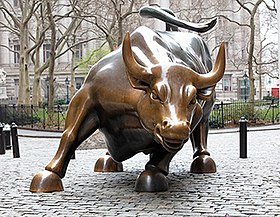
Back الثور الهائج (تمثال) Arabic Bou de Wall Street Catalan Charging Bull Czech Charging Bull German Charging Bull Esperanto Toro de Wall Street Spanish Charging Bull Estonian چارچینگ بول Persian Taureau de Wall Street French השור המסתער HE
| Charging Bull | |
|---|---|
 The sculpture in 2020 | |
| Artist | Arturo Di Modica |
| Year | 1989 |
| Medium | Bronze |
| Dimensions | 11 ft × 16 ft (340 cm × 490 cm)[1][2] |
| Weight | 7,100 pounds (3,200 kg) |
| Location | New York City, New York, US |
| 40°42′20″N 74°00′48″W / 40.705576°N 74.013421°W | |
| Website | www.chargingbull.com at the Wayback Machine (archived 2021-09-25) |
Charging Bull, sometimes referred to as the Bull of Wall Street or the Bowling Green Bull, is a bronze sculpture that stands on Broadway just north of Bowling Green in the Financial District of Manhattan in New York City. The 7,100-pound (3,200 kg) bronze sculpture, standing 11 feet (3.4 m) tall and measuring 16 feet (4.9 m) long, depicts a bull, the symbol of financial optimism and prosperity. Charging Bull is a popular tourist destination that draws thousands of people a day, symbolizing Wall Street and the Financial District.
The sculpture was created by Italian artist Arturo Di Modica in the wake of the 1987 Black Monday stock market crash. Late in the evening of Thursday, December 14, 1989, Di Modica arrived on Wall Street with Charging Bull on the back of a truck and illegally dropped the sculpture outside of the New York Stock Exchange Building. After being removed by the New York City Police Department later that day, Charging Bull was installed at Bowling Green on December 20, 1989. Despite initially having only a temporary permit to be located at Bowling Green, Charging Bull became a popular tourist attraction. Di Modica may have been influenced by a pair of huge metallic sculptures, a charging bull and a bear, placed in front of the Frankfurt, Germany Stock Exchange in 1985 as part of the 400th celebration of the exchange.
Following the success of the original sculpture, Di Modica created a number of variations of the Charging Bull which have been sold to private collectors. Charging Bull has been a subject of criticism from an anti-capitalist perspective, such as in the Occupy Wall Street protests of 2011, and has also been compared to the biblical golden calf worshiped by the Israelites shortly after their Exodus from Egypt.
© MMXXIII Rich X Search. We shall prevail. All rights reserved. Rich X Search